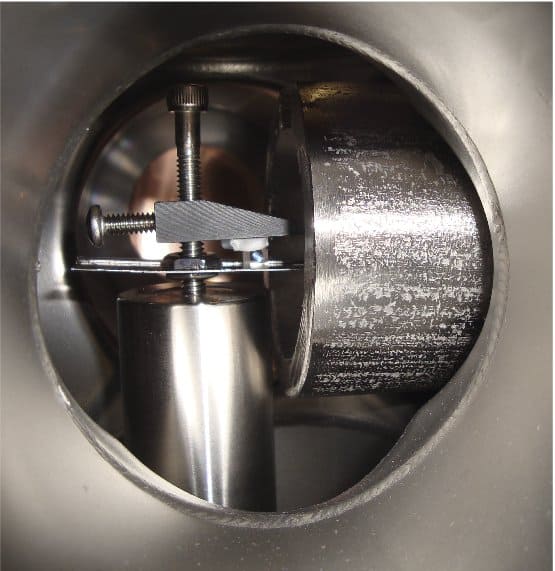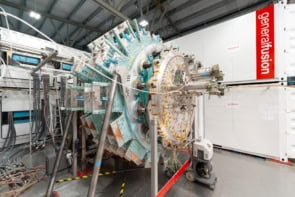
First there were atomic clocks that beat at microwave frequencies. Then along came optical clocks that provide higher frequency standards. Now, physicists in the US have unveiled plans to build the first “nuclear clock” that runs at still higher frequencies. And because it is based on a solid material, the team claims that such a frequency standard could be far less complicated than gas-based atomic and optical clocks – while delivering the same or better accuracy.
In an atomic or optical clock, electromagnetic radiation is shone on atoms that have an electronic transition involving the absorption of radiation in a very narrow frequency range. A feedback loop locks the frequency of the radiation source to that of the transition, thus creating a very stable frequency standard.
The accuracy of such a clock depends on the intrinsic width of the transition, the frequency of the transition and the experimentalist’s ability to minimize thermal fluctuations and other noise. Today, the best atomic clock has an accuracy of about one part in 1015 while an optical clock has surpassed one part in 1017 – thanks in part to a much higher operating frequency.
Thorium transitions
Now, however, the THOR collaboration including Eric Hudson and colleagues at the University of California, Los Angeles, along with physicists at Yale University and Los Alamos National Laboratory, have started to build the first frequency standard based on a nuclear transition in thorium-229. This transition is extremely narrow and occurs at about 7.6 eV, corresponding to vacuum ultraviolet light.
According to Hudson, the team plans to use a vacuum ultraviolet (VUV) frequency comb as their source of radiation. Already developed by teams at JILA and the University of Arizona, these combs provide light at a series of very precise frequencies. They could also be used to convert a very stable VUV signal into a very stable microwave signal. This is essential for comparing the output of different frequency standards because it is much easier to transfer a microwave signal between labs than a VUV signal.
The nuclear clock also differs from existing atomic and optical timekeepers – which use dilute gases – because the thorium nuclei will be embedded within a solid material.
“Because nuclear transitions are so insensitive to their environment, we believe we can build a nuclear-transition-based frequency reference by simply doping thorium into high quality crystals,” says Hudson. “Instead of the complicated room-sized implementations of current atomic and optical clocks, a nuclear frequency reference would consist of single, possibly room temperature, crystal.”
Performance limits
However, Hudson adds that a limit on the performance of their solid-state design could arise because of tiny shifts in the nuclear transition energy caused by interactions with nearby electrons. Since the electrons are sensitive to changes in the temperature of the crystal, so could the shifts in the nuclear transition energy.
“Unfortunately, even the most sensitive calculations cannot accurately predict the magnitude of this effect; therefore we will simply have to build the clock and measure how much its period depends on temperature”, says Hudson. However, he adds that even in the “worst case scenario”, the device should perform as well as current atomic clocks.
Experimental programme
The team has already carried out experiments to determine the best host crystal for the thorium, with CaF2 and LiCaAlF6 showing the most promise. The physicists then grew several LiCaAlF6 crystals doped with the much more common thorium-232 and studied their VUV properties to ensure that there are no unexpected background effects that could mask the nuclear signal.
Although satisfied that LiCaAlF6 is suitable, the team must now secure a supply of thorium-229, which currently costs a staggering $50m per gram. “We are working with our Los Alamos collaborators to open a new thorium-229 supply line through extraction from old uranium samples”, says Hudson.
Varying constants
Hudson adds that the design could also be used to look for variations in physical constants such as the fine-structure constant or the ratio of the quark masses. “An exciting feature of a nuclear transition is that it is roughly six orders of magnitude more sensitive to any fundamental constant variation than the electronic transitions used in atomic or optical clocks”, he says. “Thus, even with modest measurement accuracy we expect to be able to put severe limits on any variation of the fundamental constants.”
Patrick Gill of the UK’s National Physical Laboratory describes building such a frequency standard as “very challenging”, and points out that the exact frequency of the thorium-229 transition is not yet known. This means that the team could end up spending a great deal of time and effort just searching for the transition before it addresses other experimental obstacles.
The research is reported in Phys. Rev. Lett. 104 200802.



